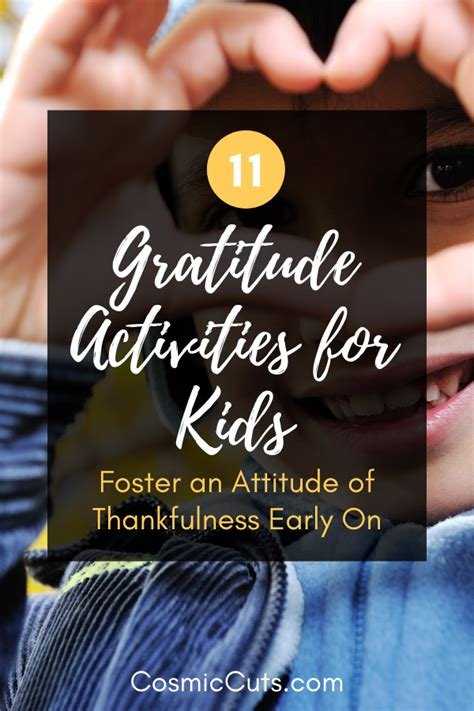Cultivating Gratitude in Kids: Activities to Foster a Sense of Thankfulness
In today’s fast-paced and often materialistic world, cultivating gratitude in children is more important than ever. Instilling a sense of thankfulness and appreciation in kids can have long-lasting effects on their overall well-being and happiness. In this blog post, we will explore the power of gratitude in childhood and why it is crucial to nurture this quality in young minds. We will also discuss various activities and practices that can help foster a sense of gratitude in kids, such as expressing gratitude through art, creating a gratitude journal, and teaching gratitude through acts of kindness. Additionally, we will delve into the impact of incorporating gratitude into daily conversations, as well as family gratitude rituals and traditions. Join us as we uncover the long-term effects of cultivating gratitude in kids and discover how these simple yet meaningful activities can make a world of difference in shaping grateful and compassionate individuals.
The Power of Gratitude in Childhood
Childhood is a time of wonder, discovery, and growth. It is also a time when the seeds of important life skills, such as gratitude, can be planted. Cultivating a sense of gratitude in children from a young age can have a profound impact on their overall well-being and outlook on life.
When children are encouraged to express and acknowledge the things they are thankful for, they develop a positive mindset that can carry them through challenging times. Gratitude helps children to focus on the good in their lives, rather than dwelling on what they lack. This shift in perspective can lead to improved mental and emotional resilience, as well as greater overall happiness.
Furthermore, instilling a sense of gratitude in childhood can lead to the development of empathy and compassion. When children learn to appreciate the things they have, they are more likely to recognize the needs of others and feel compelled to help. This can foster a sense of generosity and kindness that extends into their relationships and interactions with others.
Overall, the power of gratitude in childhood is immense. By nurturing a sense of thankfulness in young children, we can set the stage for a lifetime of positivity, resilience, and compassion.
Why Cultivating Gratitude is Important
Gratitude is a powerful emotion that has the ability to transform our lives in numerous ways. When we cultivate and practice gratitude, we are training our minds to focus on the positive aspects of life, rather than dwelling on the negatives. This shift in mindset can lead to increased happiness and overall well-being.
Expressing gratitude regularly can also improve our relationships with others. When we take the time to thank someone for their kindness or help, we are strengthening our bond with them and fostering a sense of connection and appreciation. This can lead to stronger, more fulfilling relationships with friends, family, and colleagues.
In addition, cultivating gratitude can help us cope with adversity and challenges in life. When we are able to find things to be grateful for, even in difficult times, it can shift our perspective and help us build resilience. This can lead to better mental and emotional health, as well as improved ability to deal with stress and setbacks.
Overall, the practice of gratitude is important because it has the power to improve our mindset, relationships, and ability to deal with adversity. By incorporating gratitude into our daily lives, we can experience greater happiness, stronger relationships, and improved resilience in the face of life’s challenges.
Expressing Gratitude Through Art
Art can be a powerful medium for expressing gratitude. Through visual representation, individuals can convey their appreciation for people, experiences, and blessings in their lives. Whether it’s through painting, drawing, sculpture, or other artistic forms, creating works of art allows individuals to capture the essence of gratitude in a tangible and lasting form.
When individuals engage in art as a means of expressing gratitude, they are able to tap into their creativity and imagination to convey their emotions and feelings of thankfulness. Art becomes a means of communicating their appreciation in a unique and personal way, allowing for a deeper connection to the object of their gratitude.
Art also provides a vehicle for individuals to reflect on the things they are grateful for. As they pour their thoughts and emotions into their artistic creations, they are able to contemplate the significance of these sources of gratitude and gain a deeper understanding of their impact on their lives.
Moreover, sharing these works of art with others can inspire and uplift those around them. By expressing gratitude through art, individuals can spread positivity and encourage others to reflect on their own blessings, creating a ripple effect of thankfulness in the community.
Creating a Gratitude Journal
A gratitude journal is a powerful tool for fostering a positive mindset and cultivating appreciation in our daily lives. By taking the time to reflect on the things we are grateful for, we can shift our focus from negativity to positivity. Creating a gratitude journal is a simple yet effective practice that can have a profound impact on our mental well-being.
One way to start is by choosing a notebook or journal that resonates with you. This could be a plain notebook that you decorate yourself, or a beautifully designed journal that inspires you to write in it every day. Having a dedicated space to record your gratitude can make the practice feel more special and meaningful.
Each day, take a few minutes to write down three things that you are grateful for. These could be as simple as the sunshine on a rainy day, a kind gesture from a stranger, or the laughter of a loved one. By acknowledging and appreciating these gifts in your life, you are actively cultivating a sense of gratitude and positivity.
Over time, your gratitude journal will become a treasure trove of moments, experiences, and blessings that you can look back on whenever you need a reminder of the good things in your life. The act of regularly writing in your gratitude journal can help to rewire your brain to focus on the positive, ultimately leading to a greater sense of happiness and fulfillment.
Teaching Gratitude Through Acts of Kindness
Teaching gratitude through acts of kindness can be an incredibly impactful way to instill important values in children. By encouraging them to perform acts of kindness for others, we not only teach them the value of empathy and compassion but also help them to develop a sense of appreciation for the things they have in their own lives.
One way to teach gratitude through acts of kindness is by involving children in volunteer work. This could be as simple as helping out at a local food bank or participating in a community clean-up effort. By giving children the opportunity to see the impact of their actions on others less fortunate, we can help them to understand the importance of gratitude and the value of giving back to the community.
Another way to teach gratitude through acts of kindness is by encouraging children to perform random acts of kindness for family members, friends, and even strangers. Whether it’s helping out with chores around the house, writing thank you notes, or simply sharing a smile with someone in need, these small gestures can go a long way in teaching children the importance of showing appreciation and gratitude.
Ultimately, teaching gratitude through acts of kindness is about showing children that there are countless opportunities to make a positive impact on the world around them. By cultivating an attitude of gratitude and kindness from an early age, we can help to shape children into compassionate and grateful individuals who will carry these values with them throughout their lives.
Gratitude Scavenger Hunt for Kids
Engaging children in activities that promote gratitude can have a lasting impact on their development and overall well-being. One fun and interactive way to cultivate gratitude in kids is by organizing a gratitude scavenger hunt. This activity not only encourages children to appreciate the world around them but also teaches them to express gratitude for the simple things in life.
During the gratitude scavenger hunt, children are given a list of items or experiences to find or observe, such as a beautiful flower, a kind gesture, or a moment of laughter. As they search for these items, they are prompted to reflect on why each item is meaningful and how it brings joy or beauty to their lives. This process encourages mindfulness and a deeper appreciation for the little things that are often taken for granted.
By participating in a gratitude scavenger hunt, children learn to pay attention to their surroundings and recognize the abundance of goodness in their lives. This activity also provides an opportunity for parents and caregivers to engage in meaningful conversations with their children about gratitude and the importance of acknowledging the positive aspects of life.
Overall, a gratitude scavenger hunt for kids is a creative and effective way to instill the values of gratitude and mindfulness at a young age. It encourages children to shift their focus from what they lack to what they have, fostering a positive outlook and a grateful heart.
Storytelling to Instill Gratitude
Storytelling has been a powerful tool for instilling gratitude in children for generations. Through stories, children can learn valuable life lessons, empathize with others, and develop a deeper understanding of the world around them. By incorporating gratitude into these narratives, parents and educators can help children cultivate a greater sense of appreciation for the people and blessings in their lives.
One way to use storytelling to instill gratitude is by choosing books and tales that explicitly address themes of thankfulness and appreciation. Books that highlight the importance of saying thank you, acknowledge the efforts of others, or showcase characters who overcome challenges with a positive attitude can all help reinforce the value of gratitude in children’s minds.
Additionally, parents and teachers can create their own stories or fables that center around the concept of gratitude. By actively involving children in the storytelling process, they become more deeply engaged in the message and are more likely to internalize the lesson. Incorporating familiar characters or relatable situations can make the stories even more impactful and memorable.
Furthermore, storytelling can be used to demonstrate the ripple effects of gratitude and acts of kindness. By weaving narratives that show how an expression of gratitude can positively impact others, children can begin to understand the far-reaching consequences of their words and actions. This can help them cultivate a habit of expressing gratitude in their own lives.
Incorporating Gratitude in Daily Conversations
When it comes to teaching children about gratitude, one of the most impactful ways to do so is by incorporating gratitude in daily conversations. From a young age, kids are constantly absorbing information from their surroundings, and as parents and caregivers, we have a unique opportunity to instill positive values through our everyday interactions.
By consciously and regularly expressing gratitude in our conversations with children, we can help them develop a deeper understanding of the concept and cultivate a mindset of appreciation. Whether it’s expressing gratitude for a delicious meal, acknowledging acts of kindness from others, or simply being thankful for the little things in life, these conversations can have a profound impact on a child’s outlook on the world.
Furthermore, incorporating gratitude into daily conversations also helps children learn to recognize and verbalize their own feelings of appreciation. This can empower them to communicate their emotions in a positive and constructive manner, leading to stronger relationships and a more optimistic worldview.
As adults, we can lead by example by consistently weaving gratitude into our conversations, demonstrating the importance of acknowledging and valuing the blessings we have in our lives. By fostering a culture of gratitude within our families and communities, we can create a ripple effect of positivity that extends far beyond our immediate interactions.
Family Gratitude Rituals and Traditions
Family gratitude rituals and traditions are a powerful way to create a sense of togetherness and appreciation within the family unit. These rituals can be as simple as going around the dinner table and having each family member share something they are grateful for, or as elaborate as creating a gratitude altar in the home where everyone can contribute items or notes of gratitude. By incorporating these rituals into the family routine, parents can teach their children the importance of gratitude and instill a positive mindset from an early age.
One beautiful way to foster gratitude in the family is by creating gratitude jars that family members can contribute to throughout the year. Each week, family members can write down something they are grateful for and place it in the jar. At the end of the year, the family can gather together and read through all of the notes, reflecting on the many blessings they have received. This simple ritual can help to reinforce a culture of gratitude within the family and provide a sense of joy and fulfillment.
Another meaningful tradition to incorporate into family life is the practice of expressing gratitude through acts of service. This can involve volunteering as a family at a local shelter or food bank, or even performing random acts of kindness for strangers. By engaging in these acts of service, family members can learn the value of giving back and appreciate the blessings they have in their own lives. This tradition not only teaches gratitude, but also fosters a sense of empathy and compassion.
Family gratitude rituals and traditions have the power to shape the way children view the world and their place in it. By incorporating these practices into family life, parents can help their children develop a lifelong attitude of gratitude that will serve them well into adulthood.
The Long-term Effects of Cultivating Gratitude in Kids
When children learn to cultivate gratitude from a young age, the effects can be long-lasting and impactful. Teaching children to express and experience gratitude is crucial for their emotional and psychological development. Studies have shown that kids who are taught to be grateful are more likely to have a positive outlook on life and are better equipped to handle stress and adversity in the future.
Furthermore, cultivating gratitude in children helps them develop strong social relationships and empathy towards others. When kids learn to appreciate the kindness and generosity of others, they are more likely to pay it forward and engage in acts of kindness themselves. This not only creates a positive impact on their immediate social circle but also contributes to building a more compassionate and caring society.
Additionally, the long-term effects of instilling gratitude in kids can be seen in their academic and professional lives. Grateful children tend to be more motivated, focused, and resilient in the face of challenges. They are more likely to be optimistic and have a greater sense of purpose, which contributes to their overall well-being and success in various aspects of their lives.
Incorporating gratitude into a child’s daily routine and lifestyle can have profound effects that extend well into their adulthood. By nurturing a mindset of appreciation and thankfulness, children are better equipped to navigate the complexities of life and contribute positively to the world around them.
Frequently Asked Questions
What is the power of gratitude in childhood?
The power of gratitude in childhood lies in its ability to promote positive emotions, improve overall well-being, and enhance relationships with others.
Why is cultivating gratitude important for kids?
Cultivating gratitude is important for kids as it can help them develop a positive outlook on life, improve their mental health, and increase their empathy and compassion towards others.
How can kids express gratitude through art?
Kids can express gratitude through art by creating thank-you cards, drawing or painting things they are thankful for, and using art as a means to reflect on their blessings.
What is a gratitude journal and how can it be created?
A gratitude journal is a tool for recording and reflecting on things one is thankful for. It can be created by simply having a notebook or diary dedicated to writing down moments of gratitude on a daily or weekly basis.
How can gratitude be taught through acts of kindness?
Gratitude can be taught through acts of kindness by encouraging kids to perform thoughtful gestures for others and reflecting on how it feels to bring joy to someone else’s life.
What is a gratitude scavenger hunt for kids?
A gratitude scavenger hunt for kids is an activity where they search for items or experiences that make them feel grateful, thus encouraging them to actively seek out moments of thankfulness in their surroundings.
How can storytelling be used to instill gratitude in kids?
Storytelling can be used to instill gratitude in kids by sharing narratives that emphasize the value of appreciation, kindness, and the importance of being thankful for what they have.






